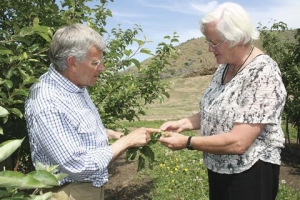
WSU apple breeder Bruce Barritt and Sue Gardiner, plant gene mapping scientist with HortResearch in New Zealand, discuss how to take leaf samples for genetic screening.
“The goal of any breeding program is to develop varieties that are profitable to the industry, whether that’s New Zealand or Washington State,” she commented during a visit to Wenatchee, Washington, this spring. “Each variety has to have a point of difference so it can be sold at the top end of the market.”
Gardiner describes genomics as a toolbox that allows breeders to more precisely and efficiently target the genes that control a particular trait they’re wanting in the fruit.
“The industry wants new varieties yesterday,” Gardiner said. “So we have to increase the efficiency and improve the timeline for the development of new varieties.”
For example, in a conventional breeding program, it might take 12 to 15 years to develop and release a new variety. But with genetic markers, elite selections can be identified quickly and crossed with other selections with desirable traits, resulting in elite selections of increasingly high quality.
It has been reported in several fruit industry publications that HortResearch’s apple breeding program is developing red-fleshed apple varieties, while also looking for disease resistance and other fruit quality attributes.
However, Gardiner said she does not think geneticists should be too rigorous in determining the desirable traits in the seedlings.
“We don’t want to take the serendipity out of breeding, and the possibility of finding something good,” she said. “That’s an illusion people have—that we’re going to do it all by markers—and that’s not true. It’s not a tool for taking over from breeders. It’s a tool to help them.”
Although it’s possible to improve apple varieties through genetic transformation rather than making crosses, scientists recognize that there would be consumer resistance. In any case, Dr. Bruce Barritt, Washington State University’s apple breeder, said he’s not looking for improved varieties, but brand new ones. Like other products, apple varieties become stale after a certain time, and people lose interest in them, he noted.
Dr. Eric van de Weg, geneticist at the University of Wageningen in the Netherlands, said Elstar (a cross of Golden Delicious and Ingrid Marie bred at Wageningen) saved the Dutch apple industry from bankruptcy 20 years ago. Now, growers are looking for a new cultivar that might have the Elstar effect.
Plant Research International, a private company that works closely with the University of Wageningen, runs the breeding program for rosaceous crops, such as apple. The program aims to develop high-quality varieties that meet consumer preferences in order to improve profitability, van de Weg explained.
“If you can deliver a product with predictable high quality, you can have high prices,” he said.

Leave A Comment